Drip fertilization, also known as drip fertigation, is a method of delivering fertilizers and other nutrients directly near the root zone of plants through a network of small tubes or pipes. This technology is ideal for fruit crop growth because it perfectly manages the nutrients provided to the plants, resulting in healthier and more prolific fruit crops. Let’s check out the drip fertigation in fruit crops below.
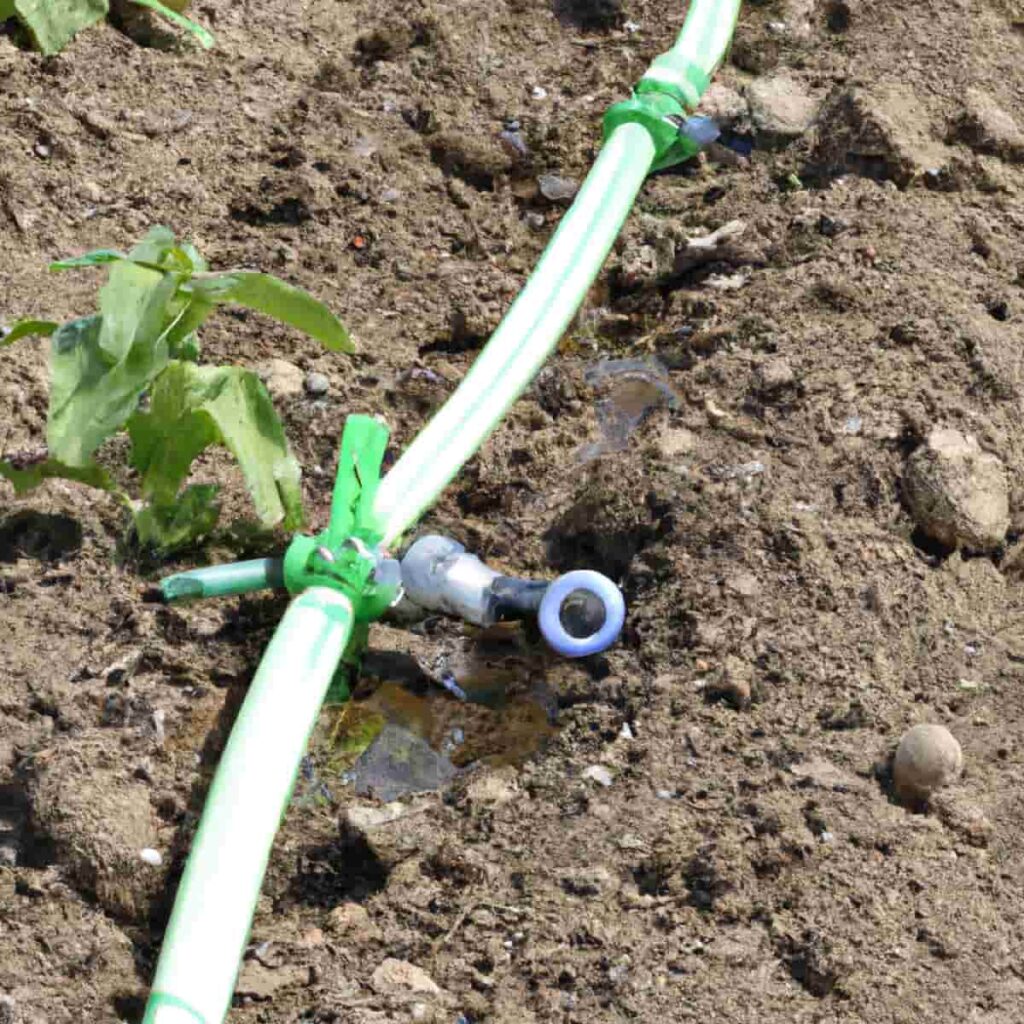
One of the primary advantages of drip fertigation is that it conserves water and reduces runoff. The water-soluble nutrients are given straight to the plant’s root zone, minimizing the water required to dissolve and transport the nutrients. It saves water and reduces the risk of nutrient leaching and runoff, which can pollute neighboring waterways. Another advantage of drip fertigation is its ability to increase the efficiency of nutrient uptake by plants. The nutrients are directly delivered to the root zone, where plants can absorb them more easily.
This results in higher crop yields and more efficient use of fertilizers. Drip fertigation can also improve soil health by promoting the growth of beneficial microbes in the root zone. These microbes help break down organic matter and release nutrients unavailable to plants. It can improve soil fertility and lead to healthier, more productive fruit crops. This article explains several fertilization elements, such as its impact on tree growth, yield, quality of fruits, Pros and Cons, and Fertigation schedules for significant fruit crops.
Drip fertigation in fruit crops
What is drip fertigation
Fertigation is the process of introducing nutrients into plants’ root zone through irrigation. Drip fertigation delivers fertilizers and water to plants through a drip irrigation system. It allows for the precise application of nutrients directly to the root zone of plants, resulting in an efficient use of resources and a reduced potential for nutrient loss through leaching or evaporation.
In case you missed it: Lentil Farming Practices: Cultivation and Production Guide for Beginners
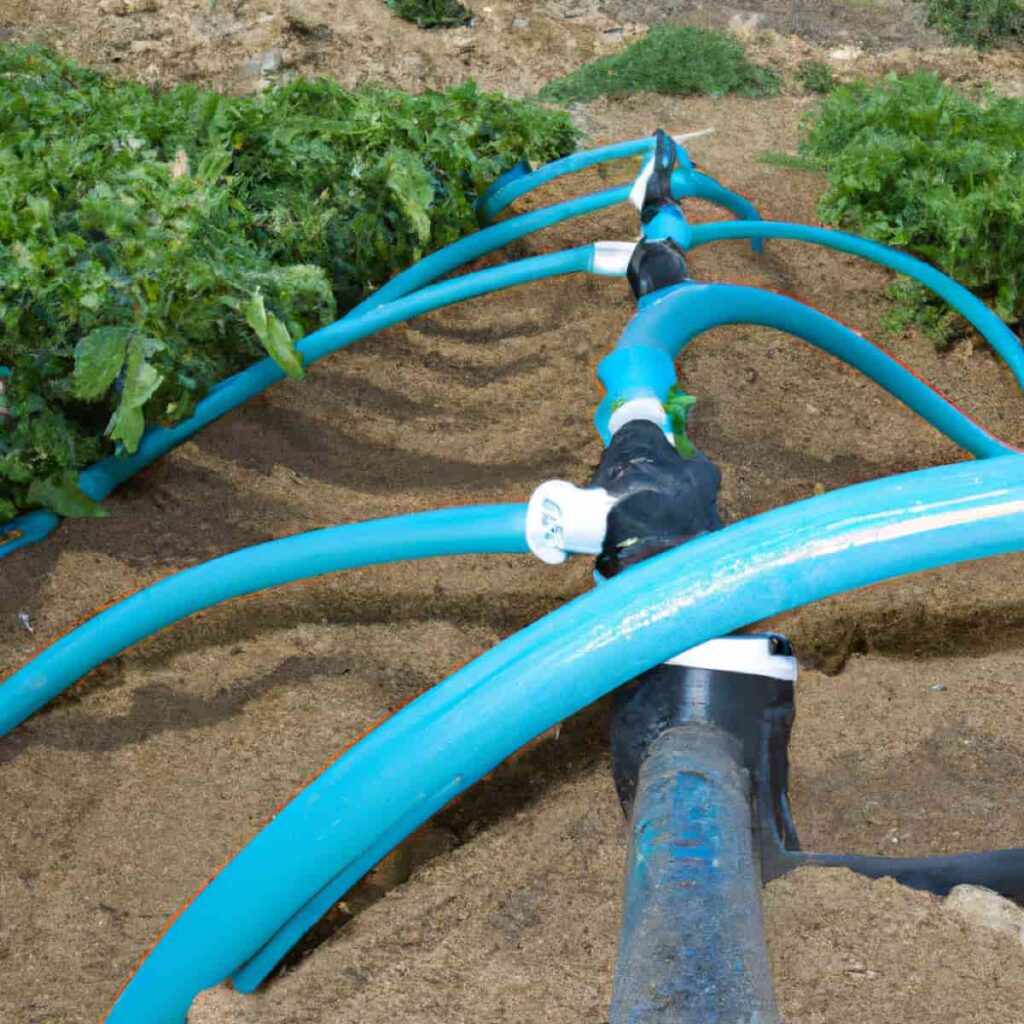
Drip fertigation can be used in outdoor and indoor growing systems, and it can be automated to deliver nutrients to plants consistently and in a consistent and controlled manner. Drip irrigation maximizes water and fertilizer efficiency by reaching the active root zone and reducing the wet area. Including fertilizer in drip irrigation lowers the expenses of irrigation and fertilizer application.
The best fertilizer or nutrients for Fertigation in Fruit crops are special fertilizers mono ammonium phosphate (Nitrogen and Phosphorus), poly feed (Nitrogen, Phosphorus, and Potassium), Multi K (Nitrogen and Potassium), Potassium nitrate ( Potassium and Nitrogen), and Potassium sulfate (Potassium and Sulphur) are ideal fertilizers Because they are highly soluble in irrigation water. Fertilizers such as superphosphate, granular fertilizers, and slow-releasing fertilizers that are insoluble and cause precipitation issues, clogging, and blockages should be avoided during Fertigation with irrigation water.
Difference between soil application, drip, and fertigation fertilizer use efficiency
| Soil application | Drip | Fertigation | |
| N | 30-50 | 65 | 95 |
| P | 20 | 30 | 45 |
| K | 50 | 60 | 80 |
Nutrient usage efficiency in drip fertigation could be as high as 75%-90%, compared to 40%-50% in conventional approaches.
Drip fertigation promotes the growth of fruit crops
Drip fertigation is also an efficient method of watering plants, as it reduces the amount of water lost through evaporation and runoff. It can be especially beneficial in areas with limited water resources or high temperatures. Fertigation scheduling is the delivery of water and nutrients at specific crop stages by drip fertigation. Fruit crops, such as apples, oranges, and strawberries, can significantly benefit from drip fertigation.
In case you missed it: Growing Spinach Organically in Telangana: Cultivation Practices and Production Guide

By providing the plants with the proper nutrients at the right time, fruit crop yields can be increased, and the quality of the fruit can be improved. First, install a drip irrigation system to use drip fertigation for your fruit crops. It can be done by hiring a professional or following do-it-yourself instructions. After setup, begin adding fertilizers to the irrigation water according to the specific needs of your plants.
Following the recommended fertilization rates and schedules provided by the manufacturer or a professional is essential. Over-fertilization can lead to plant stress and reduced yields. At the same time, under-fertilization can result in nutrient deficiencies and reduced plant growth. Drip fertigation helps for promoting the growth and development of fruit crops. By providing the plants with the proper nutrients and water at the right time, you can increase yields and improve the quality of your fruit.
Drip fertigation of fruit crops at different stages
Drip Fertigation, or applying fertilizers through irrigation systems, can be beneficial at several stages of fruit crop growth. Here are some critical stages at which Fertigation may be applied:
- During planting or transplanting: Applying fertilizers through the irrigation system during planting or transplanting can help establish strong root systems and support healthy growth.
- Early vegetative growth: Providing adequate nutrients to support leaf and stem growth during the early stages is essential. Fertigation can help ensure that these nutrients are readily available.
- Flowering and fruit set: As flowers begin to form, fertilizers can help support their development and increase the chances of a successful fruit set.
- Fruit development: As the fruit grows and matures, it is vital to provide adequate nutrients to support healthy development. Fertigation can help ensure that these nutrients are readily available.
- Harvest: During the harvest season, fertilizers can help support the plant’s overall health and improve the fruit’s quality.
The following water-soluble fertilizer combinations can be used for drip fertigation: Urea (46:0:0); Nitrate of Ammonium (34:0:0); Ammonium Sulfate salt (21:0:0); Urea Phosphate (17:44:0); Mono Ammonium Phosphate (12:61:0), and Mono Potassium Phosphate (13:0:45).
Fruit crops suitable for drip fertigation
- Citrus: Citrus fruit trees, such as oranges, lemons, and grapefruits, can benefit from drip fertigation systems as it allows for more precise application of fertilizers and water to the root zone.
- Avocado: Avocado trees have a high water and nutrient requirement, making drip fertigation systems suitable for their irrigation and fertilization needs.
- Stone fruit: Stone fruit trees, such as peaches, mango, plums, and nectarines, can also benefit from drip fertigation systems as it allows for the precise application of water and nutrients to the root zone.
- Grapes: Grapes are a high-yield crop that requires consistent irrigation and fertilization to produce a good crop. Drip fertigation systems can provide these needs while minimizing water and fertilizer waste.
- Apples: Apple trees require consistent irrigation and fertilization to produce high-quality fruit. Drip fertigation systems can provide these needs while minimizing water and fertilizer waste.
- Pears: Pear trees also require consistent irrigation and fertilization to produce high-quality fruit. Drip fertigation systems can provide these needs while minimizing water and fertilizer waste.
In case you missed it: How to Grow Pigeon Pea/Red Gram/Toor Dal: Cultivation Practices and Production Management
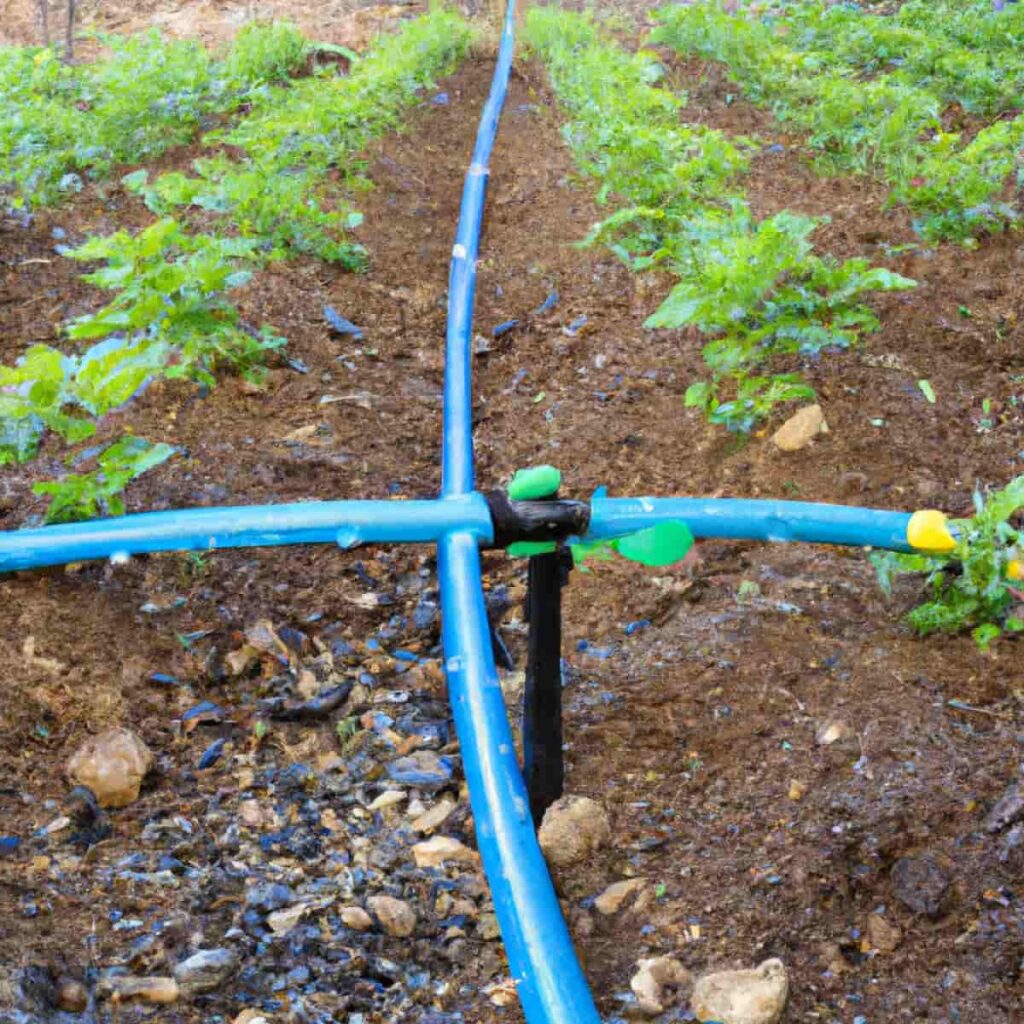
Impact of drip fertigation on fruit crop
- Improved nutrient uptake: By delivering nutrients directly to the root zone, plants can take the nutrients more efficiently. It can help ensure that the plants get the right balance of nutrients needed to grow and produce fruit.
- Reduced water and nutrient losses: With drip irrigation, the water and nutrients are delivered directly to the plants rather than being sprayed over the entire field. It reduces the amount of water and nutrients lost through evaporation or leaching, making them more efficient for the plants.
- Better root growth: Drip fertilization encourages the development of deep, healthy roots. It helps plants absorb more water and nutrients, improving overall growth and productivity.
- Greater disease resistance: By applying water and nutrients directly to the root zone, drip fertilization can help reduce the spread of diseases transmitted through soil or water. It can help improve the overall health of the plants and increase their resistance to pests and diseases.
Schedule of drip fertigation for major fruit crops
| Fruit Crop | Spacing | Recommended Fertilizers (RDF) (g NPK / plant/year) |
| Mango | 10 m x 10 m & 5 m x 5 m | 738:180:680 |
| Banana | 1.8 m x 1.8 m | 200 : 100 : 200 |
| Sapota | 8 m x 8 m | 1-3 years : 250:125:125; 4-6 years: 500:250:250; 7-10 years : 1000:500:500 |
| Papaya | 1.8 m x 1.8 m | 250: 250 : 500 |
| Grapes | 3 m x 2m (Seedless varieties) | 300:300:600 kg NPK/ha/year, for seedless cultivars |
| Guava | 4 m x 4 m | 300:300:600 kg NPK/ha/year, for seedless cultivars |
Drip irrigation scheduling & Fertigation in fruit crops
- Begin drip irrigation in the early morning or late afternoon to avoid evaporation during the hottest part of the day.
- Apply 75% RDF by Fertigation with water-soluble fertilizers.
- Monitor soil moisture levels regularly and adjust the irrigation schedule accordingly.
- Avoid overwatering, as this can lead to reduced fruit production and increased disease risk.
- During the fruiting season, increase the irrigation frequency to ensure that the plants have sufficient water to support their growing fruit.
- Use soil moisture sensor to help determine the optimal irrigation schedule for your specific crop and soil conditions.
In case you missed it: Role of Plant Breeding and Biotechnology: Crop Improvement in Agronomic Crops and Horticulture Crops
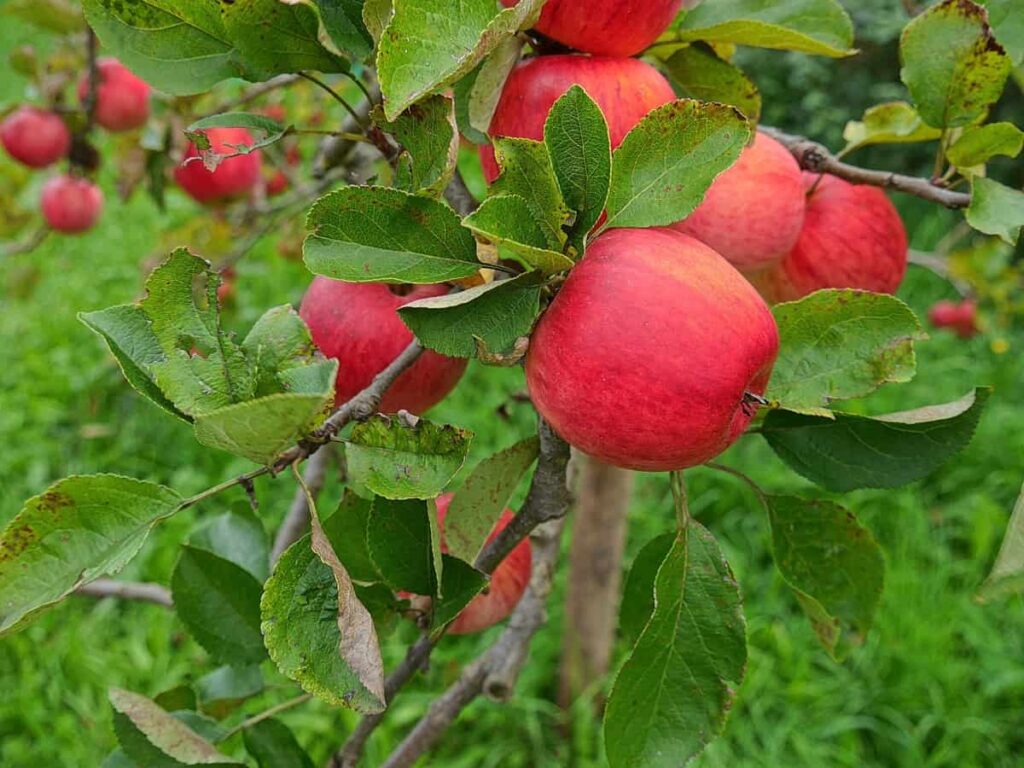
Drip fertigation equipment used in fruit crops
The tools and techniques used to supply fertilizers and other nutrients to plants via a drip irrigation system called “drip fertigation equipment.” These tools and systems are designed to provide precise and consistent delivery of nutrients to plants, which can improve plant growth, fruit quality, and yield.
- Drip irrigation system: This is a system of pipes and emitters that deliver a consistent, controlled flow of water and nutrients directly to the roots of the fruit trees.
- Venture: It works on the venture concept, where a flow constriction on the pipeline with specific entrance and exit conditions creates a vacuum due to the increased flow velocity through construction. The venture has a suction rate of 30-120 lit/hour.
- Fertilizer injectors: These devices allow you to mix and inject specific fertilizers into the irrigation system.
- Fertilizer tanks: These tanks store and mix the fertilizers applied through the drip irrigation system.
- Flow meters: These devices measure the flow rate of water and nutrients through the drip irrigation system, ensuring that the correct amount is delivered to the plants.
- Pressure regulators: These devices control the pressure of the water and nutrient solution, ensuring that it is at the correct level for optimal plant growth.
- Filters: These devices remove debris or particles from the water and nutrient solution before it reaches the plants, ensuring that the plants receive clean water and nutrients.
- Valves: These devices control the flow of water and nutrients through the drip irrigation system, allowing you to customize the delivery rate to different parts of the fruit crop.
How to apply fertilizers in fruit crops using drip irrigation
- Determine the nutrient needs of the specific fruit crop being grown. This information can typically be found on the fertilizer label or through consultation with a local extension agent or horticulturalists.
- Calculate the quantity of fertilizer needed based on the crop’s nutrient needs and the size of the irrigation area.
- Mix the appropriate fertilizer into the irrigation water according to the manufacturer’s instructions.
- Set the drip irrigation system to deliver the fertilized water to the fruit trees or shrubs at the recommended frequency and duration.
- Monitor the soil and plant growth regularly to ensure the fertilizer application is effective and the plants receive the necessary nutrients. Adjust the fertilization schedule as needed.
Companies that supply drip irrigation and fertigation equipment for fruit crops
- Netafim: This is a global leader in drip irrigation and precision irrigation solutions. They offer a wide range of products and services for fruit crops.
- Jain Irrigation: This company is based in India and offers drip irrigation systems for various fruit crops, including grapes, citrus, mango, and avocado.
- Lindsay Corporation: This company offers a range of drip irrigation solutions for fruit crops, including apples, peaches, and cherries.
- Rain Bird: This company offers drip irrigation systems for fruit crops, including berries, stone fruits, and citrus.
- Rivulis: This company offers a range of drip irrigation products for fruit crops, including citrus, avocado, mango, and stone fruits.
It is essential to research and compare different companies and their products to find the best solution for your specific needs and budget.
In case you missed it: High Yield Hybrid Grapes Varieties in India: State Wise Varieties Cultivated
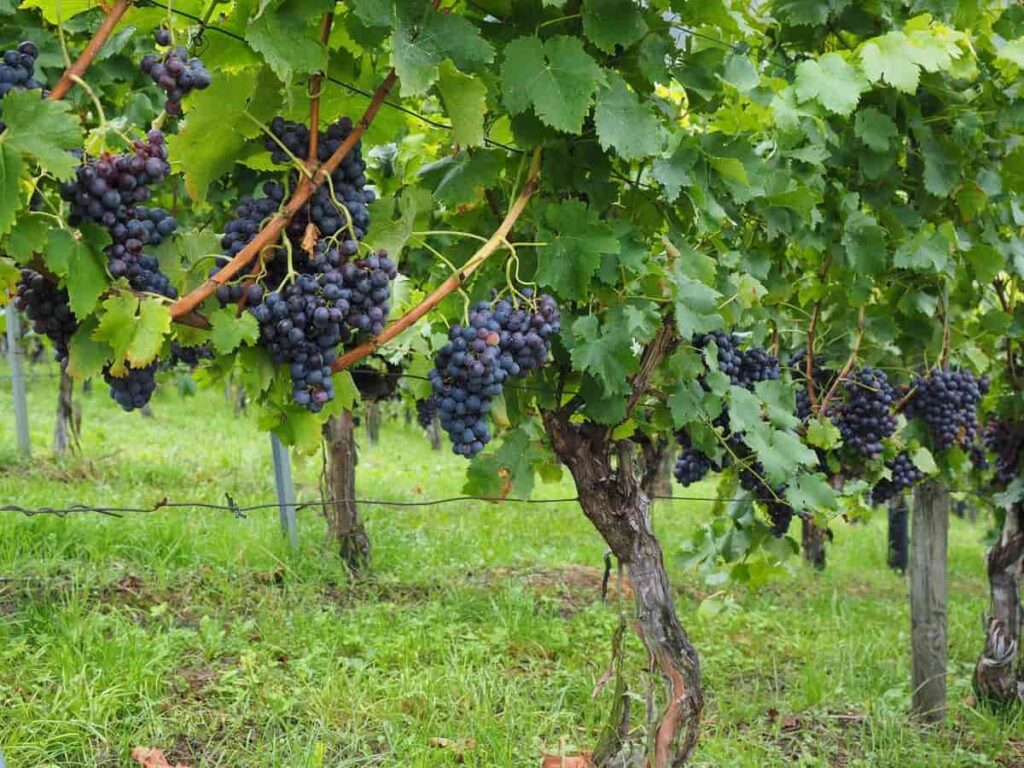
Pros of drip fertigation in fruit crops
- Increased efficiency: Drip fertigation allows for the precise delivery of nutrients directly to the roots of the plants, reducing the number of nutrients wasted through leaching or evaporation. This results in higher crop yields and better use of resources.
- Improved water management: Drip Fertigation helps to conserve water as it allows for precise control of the amount of water and nutrients applied to the plants. It reduces the risk of over-irrigation, which can lead to soil erosion and water pollution.
- Increased crop quality: By providing the right amount of nutrients at the right time, drip fertigation can improve the overall quality of the fruit crops, including size, taste, and appearance.
- Reduced labor costs: Drip fertigation systems are automated, requiring minimal labor input. It can lead to reduced labor costs and less labor-intensive farming practices.
- Increased profitability: The increased efficiency and crop quality resulting from drip fertigation can lead to increased profitability for fruit farmers.
- Greater control over nutrient application: With drip irrigation systems, farmers have greater control over the amount and timing of nutrient application, allowing them to tailor the fertilization program to the specific needs of their crops.
Cons of drip fertigation in fruit crops
- Cost: Drip fertigation systems can be expensive to install and maintain, especially for larger fruit crops.
- Complexity: Setting up and managing a drip fertigation system can be complex and time-consuming, requiring specialized knowledge and equipment.
- Pest and disease problems: Drip fertigation systems can also increase the risk of pest and disease problems. The concentrated application of water and nutrients can create an ideal environment for these issues to thrive.
- Water wastage: If not correctly managed, drip fertigation systems can lead to excessive water usage and potential water wastage, especially in areas with water shortages or drought conditions.
- Broccoli Varieties: Choosing the Right Cultivars for Your Farm
- How to Raise Pigs in Your Own Backyard: A Comprehensive Guide
- Budget Friendly Sheep Shed Ideas: Cheap and Low-Cost Tips
- How Much Do Cattle Farmers Make: Revenue Streams in Cattle Farming
- Management Pests and Diseases in Your Cotton Field
- Sheep Farming Business Plan for Beginners
- Aquaponic Farming at Home: A Step-By-Step Guide
- Profitable Village Farming Business Ideas in 2024
- High-Yield Aquaculture: Fast-Growing Fish for Farming
- Effective Fish Pond Construction Techniques for Beginners
- Irrigation and Water Management in Pineapple Farming
- Blossom to Harvest: Mastering Flowering and Pollination in Papaya Farming
- Pig Fattening Essentials: From Selection to Sale for Beginners
- Raising Wagyu Cattle: A Complete Guide for Premium Beef Production
- Soil Types and Their Water Holding Capacity
- Optimizing Irrigation Schedules for Coconut Groves for Enhanced Yield
- Espresso Your Garden: Coffee Grounds for Healthier Acid-Loving Plants
- The Best Soil Mix for Snake Plants: How to Mix Your Own Snake Plant Soil
- Green Thumb Success: Expert Tips for Cultivating Greenhouse Beans All Year Round
- Bloom All Year Round: The Ultimate Guide to Indoor Hyacinth Care
- Eco-Friendly Gardening: How to Make Liquid Fertilizer from Kitchen Waste
- Ultimate Guide to Grow Anise in Pots: Explore Seed Propagation to Harvesting
- Guide to Raising Chester White Pigs: Discover Breed Facts to Growth Management
- Mastering the Elegance: The Ultimate Guide to Weeping Cherry Tree Care, Planting, and Maintenance
- Ultimate Guide to Planting Garlic in Grow Bags: Growing Strategies for Beginners
- How to Fix Spider Plant Leaf-Related Problems: Natural and Organic Remedies
- 10 Reasons Why Your Tulsi Plant is Shedding Leaves: Home Remedies and Solutions
- Optimizing Growth and Yield: The Advantages of Palm Bunch Ash Fertilizer
- Utilizing Neem Oil Extract as a Natural Pesticide for Hydrangea
- From Soil to Harvest: Various Ways in Which Farmers Can Use AI Tools
- Steps to Encourage and Induce Citrus Flowers: A Comprehensive Guide
- How to Fix Snake Plant Leaf-Related Issues: Natural and Organic Remedies
- Transform Your Garden into a Fragrant Oasis with Raat Ki Rani (Night Blooming Jasmine)
- Discover the Ideal Chicken Breeds for Philippine Farms
- How to Create a Poultry Egg Farm Business Plan for Profits
- Grow Lemon Cucumbers Like a Pro: Insider Techniques for Bountiful Yields
